Blank B.E., Krantz S.G. Calculus: Single Variable
Подождите немного. Документ загружается.


r 5
M
R
T
0
cðt Þdt
:
⁄ EX
AMPLE 5 A doctor injects 3 mg of dye into a vein near the patient’s
heart. The aortic concentration measurements have been tabulated, with time t
given in seconds and concentration c (t) given in milligrams per liter. Estimate the
patient’s cardiac output.
t 0
1 2345678
c(t) 0 0.54 2.7 6.6 8.9 6.4 3.1 1.2 0
Solution Because the partition has nine equally spaced points forming an even
number (N 5 8) of equal length subintervals, Simpson’s Rule is applicable:
Z
8
0
cðt Þdt
8 2 0
3 8
ð1ð0Þ1 4ð 0 :54Þ1 2ð2:7Þ1 4ð6:6Þ1 2ð8:9Þ1 4ð 6 :4Þ
1 2ð3:1Þ1 4ð1:2Þ1 1ð0ÞÞ
29:453:
Therefore r is approximately 3/29.453 L/s, or 180/29.453 5 6.11 L/min.
¥
INSIGHT
In Example 5, notice that the two data points equal to 0 have been
included in the sum just as they would have been had they had nonzero values. It is a
common error to omit data points that are 0 because they seem not to contribute to the
sum. In fact, each member of the sequence of data points, f (x
0
), f (x
1
), f (x
2
), f (x
3
),...
must be multiplied by the corresponding member of the sequence of coefficients, 1, 4,
2, 4, . . . (in the case of Simpson’s Rule). Omitting an f (x
j
) that is 0 will lead to the
subsequent data points being multiplied by the wrong coefficients.
QUICK QUIZ
1. Approximate
R
5
1
ð6=xÞdx by the Midpoint Rule with N 5 2.
2. Approximate
R
5
1
ð15=xÞdx by the Trapezoidal Rule with N 5 2.
3. Approximate
R
5
1
ð45=xÞdx by Simpson’s Rule with N 5 4.
4. Approximate
R
3:5
2:5
f ðxÞdx by a) the Midpoint Rule, b) the Trapezoidal Rule,
and c) Simpson’s Rule, using, in each case, as much of the data, f (2.5) 5 24,
f (3.0) 5 36, and f (3.5) 5 12, as possible.
Answers
1. 9 2. 28 3. 73 4. a) 36, b) 27, c) 30
EXERCISES
Problems for Practice
c In each of Exercises 1210, a function f, an interval I, and
an even integer N are given. Approximate the integral of f
over I by partitioning I into N equal length subintervals and
using the Midpoint Rule, the Trapezoidal Rule, and then
Simpson’s Rule. b
1. f ðxÞ5 x
2
I 5 ½1; 3; N 5 2
2. f ðxÞ5 x
1=2
I 5 ½0; 2; N 5 2
5.8 Numerical Techniques of Integration 455
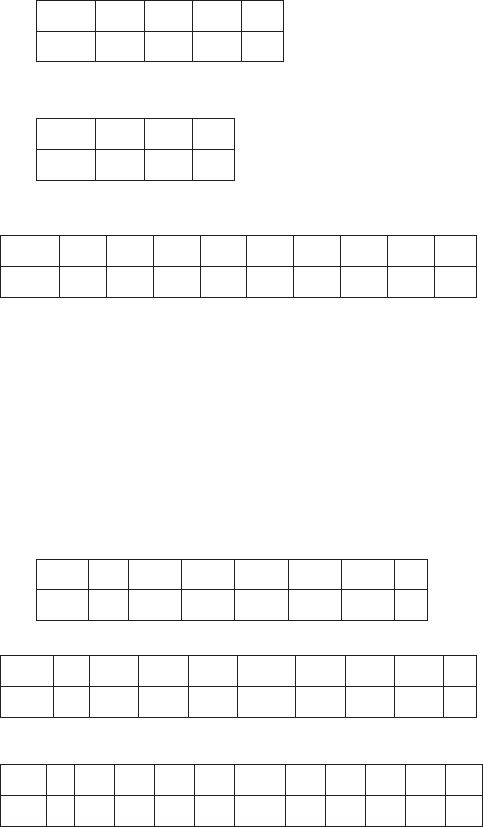
3. f ðxÞ5
ffiffiffiffiffiffiffiffiffiffiffiffiffiffiffiffiffiffiffiffiffi
2 1 x 1 x
2
p
I 5 ½2 1; 1; N 5 2
4. f ðxÞ5 ð11x
3
Þ
ð1=3Þ
I 5 ½2 1; 1; N 5 2
5. f ðxÞ5 lnðxÞ I 5 ½1; 3; N 5 2
6. f ðxÞ5 15x=ð1 1 xÞ I 5 ½0; 4; N 5 4
7. f ðxÞ5 cosðxÞ I 5 ½π=4; 5π=4; N 5 4
8. f ðxÞ5
ffiffiffiffiffiffiffiffiffiffiffi
1 1 x
p
I 5 ½0; 8; N 5 4
9. f ðxÞ5 x
3
I 5 ½21=2; 7=2; N 5 4
10. f ðxÞ5 1=xI5 ½2; 6; N 5 4
c In each of Exercises 11214, a function f (x)
and an interval
I=[a, b] are given. Also given is the approximation M
10
of
A 5
R
b
a
f ðxÞdx that is obtained by using the Midpoint Rule
with a uniform partition of order 10.
a. Use
inequality (5.8.3) to find a lower bound α for A.
b. Use inequality (5.8.3) to find an upper bound β for A.
c. Calculate A and ascertain that it lies in the interval
[α, β]. b
11. f ðxÞ5 x 1 1=xI5 ½1=2; 7=2; M
10
5 7:93202:::
12. f ðxÞ5
ffiffiffiffiffiffiffiffiffiffiffi
1 1 x
p
I 5 ½0; 8; M
10
5 17:34205:::
13. f ðxÞ5 ð21xÞ
ð21=3Þ
I 5 ½2 1; 3; M
10
5 2:88409:::
14. f ðxÞ5 x
2
1 cosðxÞ I 5 ½0; π=2; M
10
5 2:28972:::
c In each of Exercises 15218, a function f (x)
and an interval
I 5 [a, b] are given. Also given is the approximation T
10
of
A 5
R
b
a
f ðxÞdx that is obtained by using the Trapezoidal Rule
with a uniform partition of order 10.
a. Use
inequality (5.8.6) to find a lower bound α for A.
b. Use inequality (5.8.6) to find an upper bound β for A.
c. Calculate A and ascertain that it lies in the interval
[α, β]. b
15. f ðxÞ5 x
3
I 5 ½25; 1; T
10
52158:160:::
16. f ðxÞ5 1=ð10 2 xÞ I 5 ½1; 8; T
10
5 1:51366:::
17. f ðxÞ5 xexpðx
2
Þ I 5 ½3=2; 2; T
10
5 22:64660:::
18. f ðxÞ5 secðxÞ I 5 ½0; π=4; T
10
5 0:88209:::
c In each of Exercises 19222, a function f (x)
and an interval
I=[a, b] are given. Also given is the approximation S
10
of
A 5
R
b
a
f ðxÞdx that is obtained by using Simpson’s Rule with
a uniform partition of order 10.
a. Use
inequality (5.8.8) to find a lower bound α for A.
b. Use inequality (5.8.8) to find an upper bound β for A.
c. Calculate A and ascertain that it lies in the interval
[α, β]. b
19. f ðxÞ5 x
5
I 5 ½1; 4; S
10
5 682:54050:::
20. f ðxÞ5 1=xI5 ½2; 10; S
10
5 1:61008:::
21. f ðxÞ5
ffiffiffiffiffiffiffi
ðxÞ
p
I 5 ½1; 9; S
10
5 17:33275:::
22. f ðxÞ5 10 sinðxÞ I 5 ½0; 3π=2; S
10
5 10:00281:::
c Income data for three countries are given in the following
tables.
In each table, x represents a percentage, and L(x) is
the corresponding value of the Lorenz function, as described
in Example 3. In each of Exercises 23227, use the specified
approximation
method to estimate the coefficient of
inequality for the indicated country. (The values L (0) 5 0
and L (100) 5 100 are not included in the tables, but they
should be used.) b
x 20
40 60 80
L(x) 5203055
Income Data, Country A
x 25 50 75
L(x) 15 25 40
Income Data, Country B
x 10 20 30 40 50 60 70 80 90
L(x) 4 8 14 22 32 42 56 70 82
Income Data, Country C
23. Country A, Trapezoidal Rule
24. Country B, Trapezoidal Rule
25. Country C, Trapezoidal Rule
26. Country B, Simpson’s Rule
27. Country C, Simpson’s Rule
c In Exercises 28230, use Simpson’s Rule to estimate car-
diac
output based on the tabulated readings (with t in seconds
and c(t) in mg/L) taken after the injection of 5 mg of dye. b
28.
t 0
1.5 3 4.5 6 7.5 9
c(t) 0 2.4 6.3 9.7 7.1 2.3 0
29.
t 01 23 4 5 678
c(t) 0 1.9 5.8 9.4 10.4 9.1 5.9 2.1 0
30.
t 012345 67 8910
c(t) 0 3.8 6.8 8.6 9.7 10.2 9.4 8.2 6.1 3.1 0
Further Theory and Practice
31. Use inequality (5.8.6) to determine how large N should
be to ensure that the Trapezoidal Rule approximates
R
9
1
expð2x=2Þdx to within 10
24
? How about for Simpson’s
Rule?
c In each of Exercises 32235, a function f (x)
is given. Use
inequality (5.8.3) to determine how large N must be to guar-
antee that the Midpoint Rule approximation of
R
2
22
f ðxÞdx is
accurate to within 10
23
. b
456 Chapter
5 The Integral
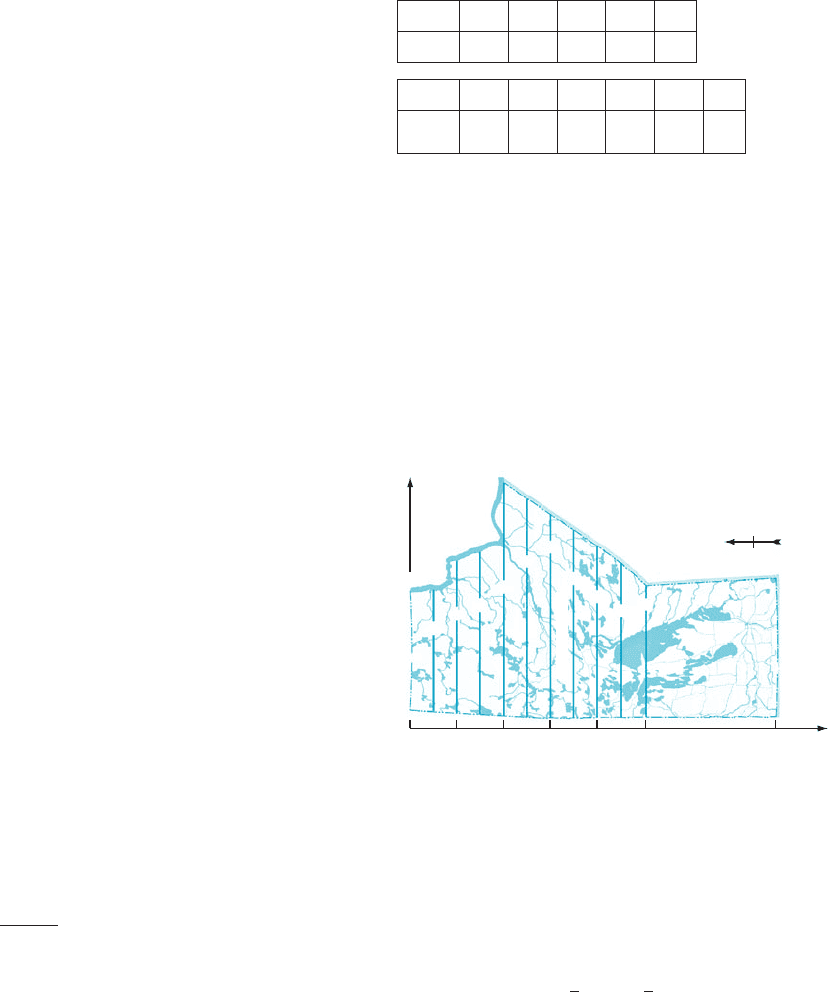
32. f (x) 5 1/(3 1 x)
33. f ðxÞ5
ffiffiffiffiffiffiffiffiffiffiffi
6 1 x
p
34. f (x) 5 e
x
35. f (x) 5 sin(π x)
c In each of Exercises 36239, a function f (x)
is given. Use
inequality (5.8.8) to determine how large N must be to
guarantee that the Simpson’s Rule approximation of
R
2
22
f ðxÞdx is accurate to within 10
23
. b
36. f (x) 5 1/(3 1 x)
37. f ðxÞ5
ffiffiffiffiffiffiffiffiffiffi
ffi
6 1 x
p
38. f (x) 5 e
x
39. f (x) 5 sin(π x)
40. Show that the Simpson’s Rule approximation is exact
when applied to a polynomial of degree 3 or less. (Hint:
Use inequality (5.8.4) to show that the error is 0.)
41. Show that the average of x
3
over the interval [γ2h, γ 1 h]
is γ (γ
2
1 h
2
). Show that this quantity is also equal to
((γ2h)
3
1 4 γ
3
1 (γ 1 h)
3
)/6. Deduce that Theorem 3,
which was stated for polynomials of degree 2, is also valid
for polynomials P (x) 5 Ax
2
1 Bx 1 C 1 Dx
3
of degree 3.
As a result, Simpson’s Rule is exact when applied to cubic
polynomials.
42. Applying Simpson’s Rule to the right side of
π 5 4
Z
1
0
ffiffiffiffiffiffiffiffiffiffiffiffiffi
1 2 x
2
p
dx
gives an approximation of π. In practice, this method of
approximation is not useful because of its computational
cost. For example, with N 5 100, the approximation is
3.1411 ..., which is accurate to only three decimal places.
Examine the graph of y 5
ffiffiffiffiffiffiffiffiffiffiffiffiffi
1 2 x
2
p
for 0 # x # 1. What
geometric property does this graph have that graphs of
approximating parabolas do not have? Why is error
bound (5.8.4) of no use here?
43. Simpson’s Rule is generally more accurate than the
Midpoint Rule, but it is not always more accurate. Cal-
culate A 5
R
1
21
ffiffiffiffiffi
jxj
p
dx. With N 5 2, estimate A using both
the Midpoint Rule, M
2
, and Simpson’s Rule, S
2
. What
are the absolute errors? Repeat with N 5 4.
44. Calculate A 5
R
1
21
jxjdx. Let N be an even positive integer
that is not divisible by 4. Show that if a uniform partition
of order N is used, then the Midpoint Rule approximation
of A is exact, but the Simpson’s Rule approximation is
not.
45. Suppose f has derivatives of order 4 in an interval con-
taining [a, b]. Chevilliet’s form of the error in Simpson’s
Rule states that the error in using Simpson’s Rule is exactly
ðb2 aÞ
4
180 N
4
ðf
000
ðξÞ2 f
000
ðηÞÞ
for two points ξ and η in [a, b]. Show that the error esti-
mate as stated in the text (sometimes known as Stirling’s
form) follows from Chevilliet’s form of the error.
c In Exercises 4
6 and 47, several values of the Lorenz func-
tion L have been tabulated (refer to Example 2). Use trape-
zoidal approximations to estimate the coefficient of inequality
that corresponds to the given data. (Note: The tables represent
partitions that are not uniform. Also, the data points (0, 0) and
(100, 100) have not been included in the tables but should be
used in the calculations.) b
46.
x 15
25 50 75 90
L (x) 319254270
47.
x 16 28 51 75 88 97
L (x) 3 8 24 46 69 88
48. Figure 11 shows a map of the province of Manitoba
flipped onto its western boundary. Distances are in kilo-
meters. The southern portion of the province, appearing
to the right in Figure 11, is essentially a trapezoid. Use
Simpson’s Rule to estimate the area of the northern
portion of the province. Approximately what is the area
of Manitoba when estimated in this way? (The actual area
is 649,953 km
2
.) Repeat with the Trapezoidal Rule.
Repeat with the Midpoint Rule using increments of 156 km
along the S-axis. (For more precise estimation, the small
arc of the eastern boundary that is not the graph of a
function must be taken into account.)
49. A 6 m wide swimming pool is illustrated in Figure 12, on
next page. Depths are given every 2 m. Estimate the
volume of water in the pool when it is filled. Use the
Midpoint, Trapezoidal, and Simpson’s Rules.
50. Let N be an even integer. The three approximation
methods discussed in this section satisfy
S
N
5
1
3
T
N=2
1
2
3
M
N=2
: ð5:8:9Þ
0
420
435
510
530
755
730
675
630
585
515
450
465
N
156 312 468 624
780
Distance
(
in kilometers
)
1225
S
E
MANITOBA
m Figure 11
5.8 Numerical Techniques of Integration 457
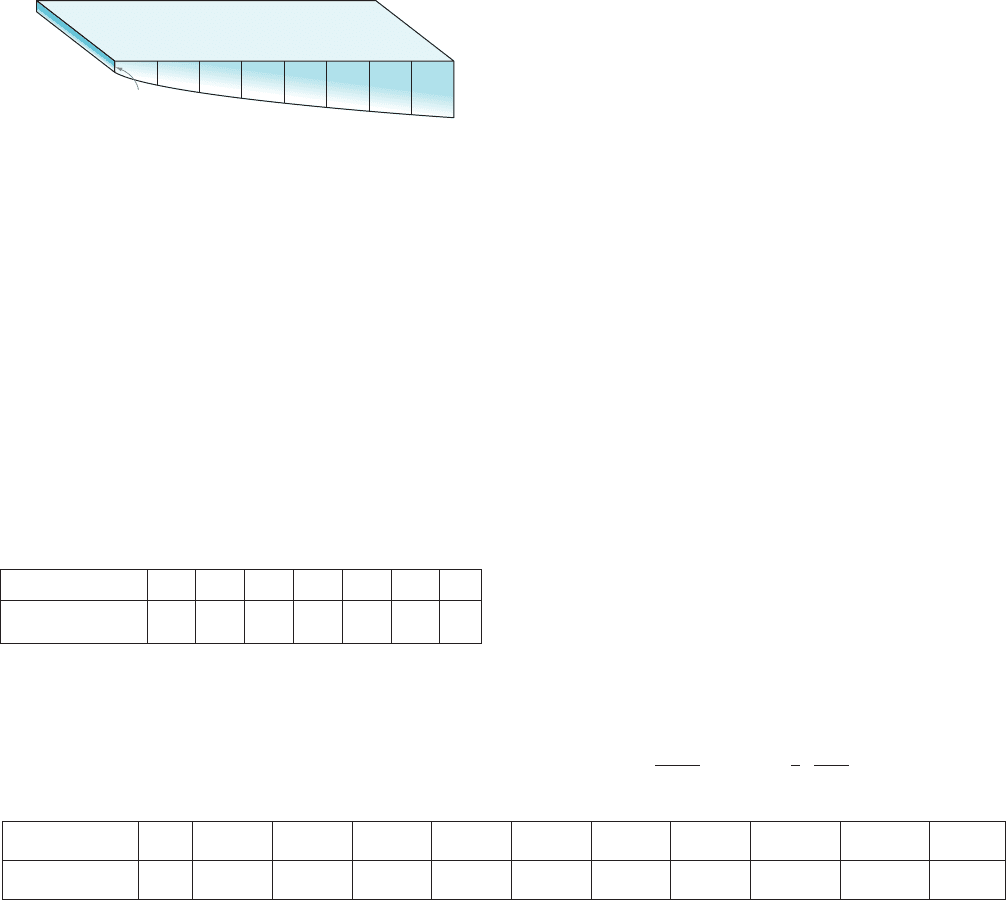
Use equation (5.8.9) to show that
ðS
N
2 T
N=2
Þ5 2 ðM
N=2
2 S
N
Þ:
c Let N be
an even integer. From equation (5.8.9) we may
deduce that one of the estimates T
N/2
and M
N/2
is greater
than or equal to S
N
, and the other is less than or equal to S
N
.
In each of Exercises 51254, calculate S
N
, M
N/2
, and T
N/2
for
the given even value of N and verify this deduction. b
51.
R
4
0
x
4
dx N 5 4
52.
R
4
0
ffiffiffi
x
p
dx N 5 2
53.
R
7
1
1=xdx N5 6
54.
R
π
0
sinðxÞdx N 5 4
55. During a 6-minute span, at intervals of 1 minute, the
speedometer of a car reads
Time (minutes) 0123456
Speed (km/hr) 90 80 75 80 80 70 60
Use Simpson’s Rule to estimate the distance traveled by
the car during that 6-minute period.
56. Speed measurements of a runner taken at half-second
intervals during the first 5 seconds of a sprint are provided
in the following table.
About how many meters did the athlete run during that
5-second interval? Use Simpson’s Rule.
Calculator/Computer Exercises
c In each of Exercises 57260, a function f and an interval [a, b]
are specified. Plot y 5 jf
00
(x)j for a # x # b. Use your plot
and inequality (5.8.3) to determine the number N of sub-
intervals required to guarantee an absolute error no greater
than 5 3 10
24
when the Midpoint Rule is used to approximate
R
b
a
f ðxÞdx. State N and the resulting approximation. b
57. f ðxÞ5
ffiffiffiffiffiffiffiffiffiffiffiffiffiffiffiffiffiffiffiffiffiffi
ffi
1 1 x 2
ffiffiffi
x
p
p
½1:25; 4
58. f ðxÞ5 x
3
=
ffiffiffiffiffiffiffiffiffiffiffiffiffi
1 1 x
2
p
½1=4; 4
59. f (x) 5 sin(x)/x [1, 5]
60. f (x) 5 sin(x
2
) [1, 2]
c In each of Exercises 61264, a function f and
an interval
[a, b] are specified. Calculate the Simpson’s Rule approx-
imations of
R
b
a
f ðxÞdx with N 5 10 and N 5 20. If the first five
decimal places do not agree, increment N by 10. Continue
until the first five decimal places of two consecutive approx-
imations are the same. State your answer rounded to four
decimal places. b
61. f (x) 5 ln(1 1 x
2
) [0, 5]
62. f ðxÞ5 expð
ffiffiffi
x
p
Þ½1; 4
63. f ðxÞ5
ffiffiffiffiffiffiffiffiffiffiffiffiffi
1 1 x
3
p
½0; 4
64. f (x) 5 sin(π cos(x)) [0, π/3]
c In each of Exercises 65268, an integral
R
b
a
f ðxÞdx and a
positive integer N are given. Compute the exact value of the
integral, the Simpson’s Rule approximation of order N, and
the absolute error ε. Then find a value c in the interval (a, b)
such that ε 5 (b2a)
5
jf
(4)
(c)j/(180 N
4
). (This form of the error,
which resembles the Mean Value Theorem, implies inequal-
ity (5.8.4).) b
65.
R
4
1
ffiffiffi
x
p
dx N 5 6
66.
R
e
1
1=xdx N5 4
67.
R
8
1
ð11 xÞ
1=3
dx N 5 4
68.
R
15
8
1=
ffiffiffiffiffiffiffiffiffiffiffi
1 1 x
p
dx N 5 4
69. Data is said to be normally distributed with mean μ and
standard deviation σ . 0 if, for every a , b, the probability
that a randomly selected data point lies in the interval [a, b]is
1
σ
ffiffiffiffiffiffi
2π
p
Z
b
a
exp 2
1
2
x2μ
σ
2
dx:
Suppose the scores on an exam are normally distributed
with mean 70 and standard deviation 15. Use Simpson’s
Rule with N 5 6 to approximate the probability that a
randomly selected exam has a grade in the range [ 55, 85].
(The answer, the probability of being within one standard
deviation of the mean, does not depend on the particular
values 15 and 70 of the parameters that are used in this
exercise.)
70. Suppose the scores on an exam are normally distributed
with mean 80 and standard deviation 10. (Refer to
Exercise 69.) What is the probability that a randomly
selected exam has a grade in the range [60, 100]? Use
3.9
6
6
0.77
1.5
2.0
2.4
2.8
3.1
3.4
3.6
m Figure 12
Time (s) 0 0.5 1.0 1.5 2.0 2.5 3.0 3.5 4.0 4.5 5.0
Speed (m/s) 0 5.26 6.67 7.41 8.33 8. 33 9.52 9.52 10.64 10.64 10.87
458 Chapter 5 The Integral
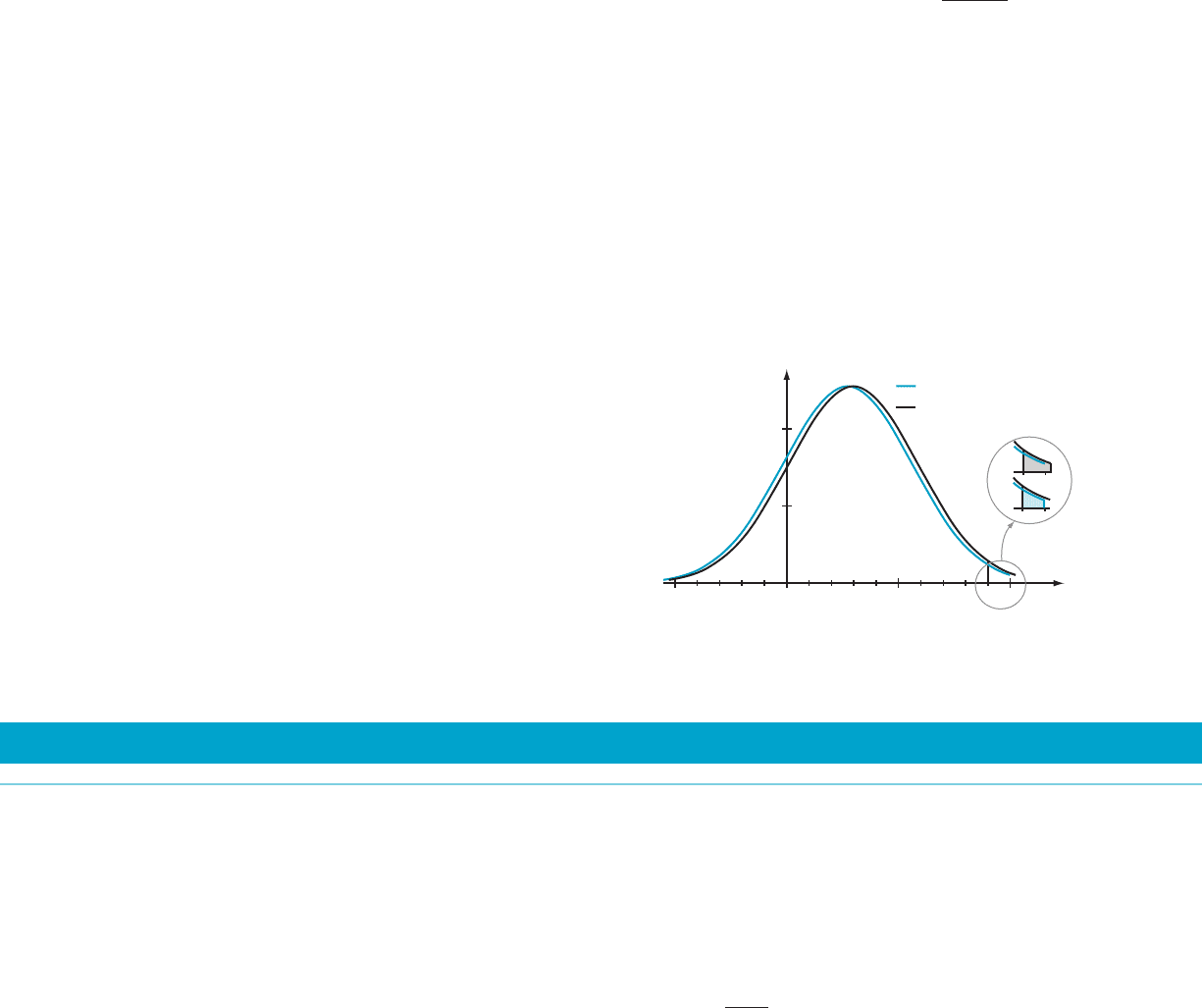
Simpson’s Rule with N 5 10. (The answer, the probability
of being within two standard deviations of the mean, does
not depend on the particular values 10 and 80 of the
parameters that are used in this exercise.)
71. The partition f0, 15, 25, 50, 75, 90, 100g of [0, 100] given in
Exercise 46 precludes an application of Simpson’s Rule
because it is not uniform. However, because the number
of subintervals is even, the idea behind Simpson’s Rule
can be used. Find the degree 2 polynomial p
1
that passes
through the three points (0, 0), (15, 3), and (25, 19). The
interpolation command of a computer algebra system will
make short work of finding this polynomial. Calculate
R
25
0
p
1
ðxÞdx. Next, find the degree 2 polynomial p
2
that
passes through the three points (25, 19), (50, 25), and
(75, 42). Calculate
R
75
25
p
2
ðxÞdx. Repeat this procedure
with the last three points, (75, 42), (90, 75), and (100, 100).
What approximation of
R
100
0
LðxÞdx results?
72. The polynomial p
1
(x) of Exercise 71 is negative on the
subinterval (0, 11.42857 ...). As a result, the value of
R
11:42857:::
0
p
1
ðxÞdx underestimates
R
11:42857:::
0
LðxÞdx.To
compensate, averaging
R
25
0
p
1
ðxÞdx with the trapezoidal
approximation of
R
25
0
LðxÞdx, which is an overestimate,
might be considered. When the calculation of Exercise
71 is amended in this way, what approximation of
R
100
0
LðxÞdx results?
73. In a particular regional climate, the temperature varies
between 222
C and 40
C, averaging μ 5 11
C. The
number of days F (T) in the year on which the tempera-
ture remains below T degrees centigrade is given
(approximately) by
FðTÞ5
Z
T
222
f ðxÞdx ð222 # T # 40Þ;
where
f ðxÞ5 12:72 exp
2
ðx2 11Þ
2
266:4
:
Notice that F (T) is the sort of area integral that we
studied in Section 5.4.
a. Use Simpson’s Rule with N 5 20 to approximate
F (40). What should the exact value of F (40) be?
b. Heat alerts are issued when the daily high temperature
is 36
C or more. On about how many days a year are
heat alerts issued?
c. Suppose that global warming raises the average tem-
perature by 1
C, shifting the graph of f by 1 unit to the
right. The new model may be obtained by simply
replacing μ with 12 and using [221, 41] as the domain
(see Figure 13). What is the percentage increase in
heat alerts that will result from this 1
C shift in
temperature?
Summary of Key Topics in Chapter 5
Sigma Notation and
Partitions
(Sections 5.1, 5.2)
The notation
X
N
j5 M
a
j
means a
M
1 a
M11
1 a
M12
1 1 a
N21
1 a
N
:
The uniform partition of order N of an interval [ a, b] is the set fx
0
; x
1
;:::;x
N
g
of points x
j
defined by
x
j
5 a 1 j
b 2 a
N
ð0 # j # NÞ:
These points divide [a, b] into N subintervals, I
j
5 ½x
j21
; x
j
ð0 # j # NÞ.
Each subinterval has length Δx 5 ðb 2 aÞ=N.
shifted temperature
density
y f(x)
y
x
20 0
5
10
20 40
m Figure 13
Summary of Key Topics 459

Area
(Section 5.1)
Let f be
a continuous positive function on [a, b]. The area of the region under the
graph of f, above the x-axis, and between the vertical lines x=a and x=b is the limit
as N tends to infinity of the expression
X
N
j5 1
f ðx
j
ÞΔx
where Δx 5 ðb 2 aÞ= N and x
1
5 a 1 Δx; x
2
5 a 1 2Δx;:::; x
N
5 a 1 NΔx 5 b.
The Riemann Integral
(Section 5.2)
If f is
any function on an interval [a, b] that has been divided into N equal width
subintervals, and if for each j a points s
j
in the jth subinterval is chosen, then the
expression
Rðf ; S
N
Þ5
X
N
j5 1
f ðs
j
ÞΔx
is called a Riemann sum for f. Here we let S
N
denote fs
1
;: : : ;s
N
g. If the Riemann
sums for f have a limit as the number N of subintervals tends to infinity, then that
limit is called the Riemann integral for f on [a, b], and f is said to be integrable on
[a, b]. The Riemann integral of f on [a, b] is denoted by
Z
b
a
f ðxÞdx
and is said to be the definite integral of f over the interval [a, b]. A definite integral is
always a number. (By contrast, the indefinite integral of f,
R
f ðxÞdx, denotes a
collection of functions of the variable of integration.)
Fundamental Theorem
of Calculus
(Sections 5.2 and 5.4)
A continuous function f is
integrable. The Fundamental Theorem of Calculus
consists of two formulas that relate differentiation and integration. Together they
imply that differentiation and integration are inverse operations. If f is continuous
on an interval I that contains the point a , then the function F de fined on I by
FðxÞ5
Z
x
a
f ðtÞdt;
is an antiderivative of f:
F
0
ðxÞ5 f ðx Þ:
If F is any antiderivative of f, then the definite integral of f can be calculated by
Z
b
a
f ðxÞdx 5 FðbÞ2 FðaÞ:
Properties of the
Integral
(Section 5.3)
The integral satisfies the following five properties. If f and g are
integrable on [a, b]
and if α is a constant, then
1.
R
b
a
ðf ðxÞ1 gðxÞÞdx 5
R
b
a
f ðxÞdx 1
R
b
a
gðxÞdx and
R
b
a
ðf ðxÞ2 gðxÞÞdx 5
R
b
a
f ðxÞdx 2
R
b
a
gðxÞdx;
2.
R
b
a
αf ðxÞdx 5 α
R
b
a
f ðxÞdx;
460 Chapter 5 The Integral

3.
R
b
a
α dx 5 α ðb 2 aÞ;
4.
R
a
a
f ðxÞdx 5 0; and
5.
R
c
a
f ðxÞdx 1
R
b
c
f ðxÞdx 5
R
b
a
f ðxÞdx:
If b , a, then we define
R
b
a
f ðxÞdx to be equal to 2
R
a
b
f ðxÞdx.Iff is continuous on
[a, b], then the Mean Value Theorem for Integrals states that there is a c in (a, b)
such that
f ðcÞ5
1
b 2 a
Z
b
a
f ðxÞdx:
Logarithmic and
Exponential Functions
(Section 5.5)
The natura
l logarithm can be defined for positive x by
lnðxÞ5
Z
x
1
1
t
dt:
All properties of the logarithm can be derived from this formula. The inverse of the
natural logarithm is called the natural exponential function,orexponential function
for short. It is denoted by exp. The number e is defined by
e 5 exp ð1Þ:
If a is any positive number, and x is any real number, then we define
a
x
5 expðx lnðaÞÞ:
The familiar laws of exponents all follow from this definition.
Substitution
(Section 5.6)
If f (x)
has the form FðϕðxÞÞ ϕ
0
ðxÞ, then the calculation of the integral of f can be
simplified by a substitution of the form
u 5 ϕðxÞ and du 5 ϕ
0
ðxÞdx:
The Calculation of Area
(Section 5.7)
If f (x) $ 0o
n[a, b], then
Z
b
a
f ðxÞdx
represents the area under the graph of f, above the x-axis, and between x 5 a and
x 5 b.Iff (x) # 0on[a, b], then the integral represents the negative of the area
above the graph of f, below the x-axis, and between x 5 a and x 5 b.
If f (x) $ g(x)on[a, b], then the area between the two graphs and between the
vertical lines x 5 a and x 5 b is given by
Z
b
a
ðf ðxÞ2 g ðxÞÞdx:
To calculate the area between two graphs, it is necessary to break up the problem
into integrals over intervals on which one of the two functions is greater than or
equal to the other.
For some types of area problems, it is useful to integrat e in the y-variable,
treating x as the dependent variable.
Summary of Key Topics 461

Numerical Integration
(Section 5.8)
Methods of approximating definite integrals are particularly useful when an anti-
de
rivative of the integrand cannot be found. Let f be a continuous function on [a, b].
For a positive integer N, let Δx =(b 2 a)/N, x
j
5 a 1 jΔx, and x
j
5 ðx
j21
1 x
j
Þ=2. The
definite integral
R
b
a
f ðxÞdx can be approximated by the Midpoint Rule:
Δx ðf ð
x
1
Þ1 f ðx
2
Þ1 1 f ðx
N
ÞÞ:
The Trapezoidal Rule for approximating
R
b
a
f ðxÞdx is
Δx
2
f ðx
0
Þ1 2f ðx
1
Þ1 2f ðx
2
Þ1 1 2f ðx
N21
Þ1 f ðx
N
Þ
:
Of these two methods of approximation, the Midpoint Rule is usually more accurate.
Still more accurate is Simpson’s Rule, which can be applied when N is even:
Z
b
a
f ðxÞdx
Δx
3
f ðx
0
Þ1 4f ðx
1
Þ1 2f ðx
2
Þ1 4f ðx
3
Þ1 1 2f ðx
N22
Þ
1 4f ðx
N21
Þ1 f ðx
N
Þ
:
For k 5 2 and k 5 4, let C
k
be a number such that the kth derivative f
(k)
satisfies
|f
(k)
(x)| # C
k
on the interval [a, b] of integration. The errors that result from using
the Midpoint Rule, the Trapezoidal Rule, and Simpson’s Rule are no larger than
C
2
24
ðb 2 aÞ
3
N
2
;
C
2
12
ðb 2 aÞ
3
N
2
; and
C
4
180
ðb 2 aÞ
5
N
4
;
respectively.
REVIEW EXERCISES for Chapter 5
c In each of Exercises 124, use sigma notation to express
the sum. b
1. 1 1 4 1 9 1 16 1
1 25
2
2. 120 1 122 1 124 1 126 1 1 240
3. 1=2 1 1=3 1 1=4 1 1=5 1 1=6 1 1 1=100
4. 1 2 2 1 3 2 4 1 5 2 6 1 2 100
c In each of Exercises 528, calculate the right endpoint
approximation of the area of the region that lies below the
graph of the given function f and above the given interval I of
the x-axis. Use the uniform partition of given order N. b
5. f ðxÞ5 x
3
I 5 ½2; 5; N 5 3
6. f ðxÞ5 1=xI5 ½1; 2; N 5 2
7. f ðxÞ5 ðx 2 1Þ=ðx 1 1Þ I 5 ½1; 4; N 5 3
8. f ðxÞ5 sinðxÞ I 5 ½0; π=2; N 5 3
c In each of Exercises 9212, for the given function f,
interval I,
and uniform partition of order N, evaluate the
Riemann sum Rðf ; SÞ using the choice of points S that con-
sists of the midpoints of the subintervals of I . b
9. f ðxÞ5 sinðxÞ; S 5 fπ=6; π=2g I 5 ½0; 2 π=3; N 5 2
10. f ðxÞ5 ð7 2 xÞ=x; S 5 f2; 4; 6g I 5 ½1; 7; N 5 3
11. f ðxÞ5 16 x
2
; S 5 f5=4; 7=4; 9=4; 11=4g I 5 ½1; 3; N 5 4
12. f ðxÞ5 x 2 x
2
; S 5 f1=8; 3=8; 5=8; 7=8g I 5 ½0; 1; N 5 4
c In each of Exercises 13228, evaluate the given definite
integral. b
13.
R
3
1
6 x
2
dx
14.
R
2
21
ð10 x
4
1 9 x
2
Þdx
15.
R
21
22
ð1=xÞdx
16.
R
9
4
ffiffiffi
x
p
dx
17.
R
4
1
ð2x 2 1=
ffiffiffi
x
p
Þdx
18.
R
π=3
π=6
sec
2
ðxÞdx
19.
R
π=3
π=6
ð4sinðxÞ2 cosðxÞÞdx
462 Chapter 5 The Integral

20.
R
π=4
0
secðxÞtanðxÞdx
21.
R
81
16
ð1=x
1=4
Þdx
22.
R
8
1
x
2=3
dx
23.
R
2
1
ð24=x
2
Þdx
24.
R
lnð3Þ
0
e
x
dx
25.
R
2
0
3
x
dx
26.
R
π=2
π=4
csc
2
ðxÞdx
27.
R
π=2
π=4
cscðxÞcotðxÞdx
28.
R
2
1
ðx
2
1 x 1 2Þ=xdx
c In Exercises 29232, compute the average value of f over
[a, b],
and find a point c in (a, b) at which f attains this
average value. b
29. f ðxÞ5 1=x
2=3
a 5 1; b 5 8
30. f ðxÞ5 x
2
a 5 1; b 5 5
31. f ðxÞ5
ffiffiffi
x
p
a 5 1; b 5 4
32. f ðxÞ5 1=x
2
a 5 1=2; b 5 3
c
In each of Exercises 33244 , a function F (x )anda
point c are given. Calculate F
0
(c). b
33. FðxÞ5
Z
x
0
t 1 3
t 1 1
dt c 5 3
34. FðxÞ5
R
x
1
t
1=3
ffiffiffiffiffiffiffiffiffiffiffiffiffiffi
ffiffi
t
p
1 1
p
dt c 5 64
35. FðxÞ5
R
x
21
ðt
3
1 20Þ=ðt 1 2Þdt c 5 2
36. FðxÞ5
R
π=4
x
tan
2
ðtÞdt c 5 π=3
37. FðxÞ5
R
2
x
sin
2
ðπ=tÞdt c 5 4
38. FðxÞ5
R
6
x
ffiffiffiffiffiffiffiffiffiffiffiffiffiffi
2t
2
2 1
p
dt c 5 5
39. FðxÞ5
R
3x
1
lnð1 1 tÞdt c 5 1
40. FðxÞ5
R
x
2
0
ffiffiffiffiffiffiffiffiffiffiffiffiffiffi
1 1
ffiffi
t
p
p
dt c 5 3
41. FðxÞ5
R
10
6x
ðt
2
1t12Þ
2=3
dt c 5 1=3
42. FðxÞ5
R
2x
x
t sinðtÞdt c 5 π=4
43. FðxÞ5
R
x
2x
ffiffiffiffiffiffiffiffiffiffiffiffi
5 1 t
2
p
dt c 5 2
44. FðxÞ5
R
x
ffiffi
x
p
ffiffi
x
p
lnðtÞdt c 5 9
c In each of Exercises 45249 use the equations
R
α
1
ð1=tÞdt 5 3 and
R
β
1
ð1=tÞdt 5 6 to evaluate
R
b
a
ð1=tÞdt over
the given interval [a, b]. b
45. [1, αβ]
46. [1, β/α]
47. [α, β]
48. [α, αβ]
49. [1, α
4
]
c In each of Exercises 50270, make a substitution, and
evaluate
the given integral. b
50.
R
6xcosðx
2
Þdx
51.
Z
cosðxÞ
sin
3
ðxÞ
dx
52.
R
24 x
ffiffiffiffiffiffiffiffiffiffiffiffiffi
1 1 x
2
p
dx
53.
R
24 x
3
=
ffiffiffiffiffiffiffiffiffiffiffiffiffi
2 1 x
4
p
dx
54.
Z
x 1 2
x
2
1 4x 1 5
dx
55.
Z
sinðxÞ
3 1 2cosðxÞ
dx
56.
R
24sinð3xÞcos
5
ð3xÞdx
57.
Z
ð
ffiffiffi
x
p
11Þ
1=3
ffiffiffi
x
p
dx
58.
Z
2 π
cosðπ=x
2
Þ
x
3
dx
59.
Z
2
x ln
2
ðxÞ
dx
60.
R
lnð2xÞ=x
dx
61.
R
12 x
ffiffiffiffiffiffiffiffiffiffiffiffiffi
4x 1 1
p
dx
62.
Z
x
2
ðx11Þ
3
dx
63.
Z
x
ffiffiffiffiffiffiffiffiffiffiffi
x 1 2
p
dx
64.
R
60 x
3
ffiffiffiffiffiffiffiffiffiffiffiffiffi
x
2
1 1
p
dx
65.
Z
arctan
2
ðxÞ
1 1 x
2
dx
66.
Z
expðxÞ
ffiffiffiffiffiffiffiffiffiffiffiffiffiffiffiffiffiffiffiffiffiffi
1 1 expðxÞ
p
dx
67.
Z
arcsinðxÞ
ffiffiffiffiffiffiffiffiffiffiffiffiffi
1 2 x
2
p
dx
68.
Z
x 1 expð2xÞ
x
2
1 expð2xÞ
dx
69.
Z
1 2 2x
ffiffiffiffiffiffiffiffiffiffiffiffiffi
1 2 x
2
p
dx
70.
Z
2 1 x
4 1 x
2
dx
c Evaluate the definite integrals in Exercises 71276. b
71.
R
π=9
0
24 tanð3xÞdx
72.
R
π
π=2
24 cotðx=3Þdx
73.
R
π=2
0
secðx=3Þdx
74.
Z
exp ð4Þ
exp ð2Þ
1
x lnðxÞ
dx
75.
R
2
0
x
3
ffiffiffiffiffiffiffiffiffiffiffiffiffi
9 1 x
4
p
dx
76.
R
1
0
x
ffiffiffiffiffiffiffiffiffiffiffi
1 2 x
3
p
dx
c In each of Exercises 77280, find the area of the region that is
bo
unded by the graphs of y 5 f (x)andy 5 g(x)forx between
the abscissas of the two point s of intersection. b
77. f ðxÞ5 4 2 x
2
gðxÞ5 3x
Review Exercises 463
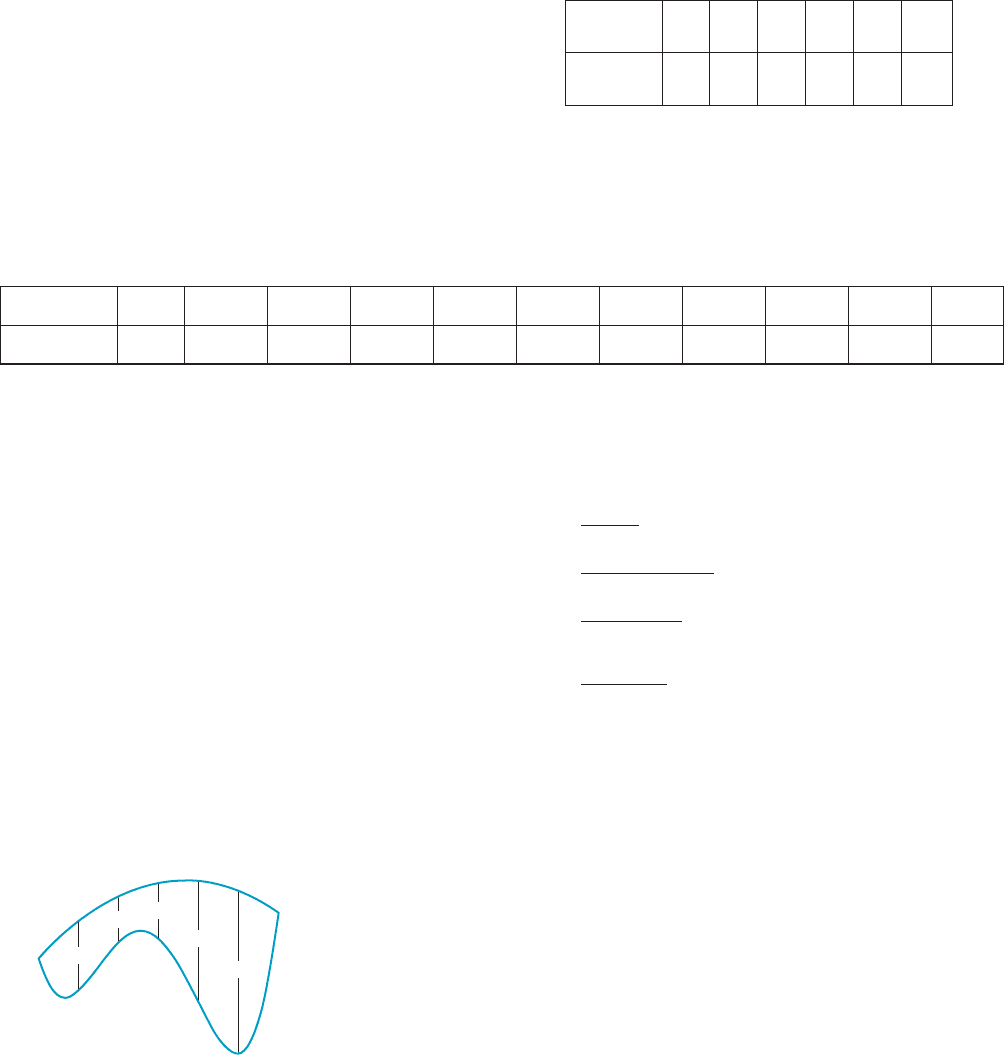
78. f ðxÞ5 x
2
1 x 1 2 gðxÞ5 18 1 x 2 x
2
79. f ðxÞ52x
4
1 x
2
1 16 gðxÞ5 2x
4
2 2x
2
2 20
80. f ðxÞ5 2
x
gðxÞ5 1 1 2x 2 x
2
c In each of Exercises 81284, find the total area of the
bounded regions whose upper and lower boundaries are arcs
of the graphs of the given functions f and g. b
81. f ðxÞ5 x
3
2 2x
2
2 3xgðxÞ5 0
82. f ðxÞ5 x
3
2 2x
2
1 3 gðxÞ5 1 1 x
83. f ðxÞ5 x
3
2 x
2
2 9x 1 4 gðxÞ525
84. f ðxÞ5 x
4
2 2x
2
1 1 gðxÞ5 1 2 x
3
c In each of Exercises 85288, a function f, an interval I, and
an even integer N are given. Approximate the integral of f
over I by partitioning I into N equal length subintervals and
using the Midpoint Rule, the Trapezoidal Rule, and then
Simpson’s Rule. b
85. f ðxÞ5 8 2 x
3
I 5 ½21; 3; N 5 2
86. f ðxÞ5 4x
3
1 1 I 5 ½1; 2; N 5 2
87. f ðxÞ5 ð 1 1 xÞ=ð1 1 4xÞ I 5 ½0; 2; N 5 4
88. f ðxÞ5 18x=ð1 1 8xÞ I 5 ½0; 1; N 5 4
c In each of Exercises 89292, a function f and
an interval
I 5 [a, b] are given. Also given is the approximation M
10
of
A 5
R
b
a
f ðxÞdx that is obtained by using the Midpoint Rule
with a uniform partition of order 10. Use the error estimate
for the Midpoint Rule approximation to find a lower bound α
and and upper bound β for A. b
89. f ðxÞ5
ffiffiffiffiffiffiffiffiffiffi
ffi
5 1 x
p
I 5 ½2 1; 11; M
10
5 37:34080:::
90. f ðxÞ5 x ð11xÞ
3
I 5 ½1; 3; M
10
5 138:08676:::
91. f ðxÞ5 ð 11xÞ
1=3
I 5 ½0; 7; M
10
5 11:25500:::
92. f ðxÞ5 lnð1 1 xÞ I 5 ½1; 6; M
10
5 7:23877:::
93. From west to east, a city is 5.1 km wide. North-south
measurements at 0.85 km intervals are given in Figure 1.
Use the Trapezoidal Rule and Simpson’s Rule to estimate
the city’s area.
94. During a 5-minute span, at intervals of 1 minute, the
speedometer of a car reads
Time
(minutes)
012345
Speed
(km/h)
80 74 60 54 46 0
Use the Trapezoidal Rule to estimate the distance tra-
veled by the car during that 5-minute period.
95. Speed measurements of a runner taken at half-second
intervals during the last 5 seconds of a sprint are provided
in the following table.
About how many meters did the athlete run during that 5-
second interval? Use Simpson’s Rule.
c In Exercises 96299, use a table of integrals to calculate the
given
integral. b
96.
Z
t
5
ð11t
3
Þ
2
dt
97.
Z
2
ð2x 1 1Þðx13=2Þ
2
dx
98.
Z
36cosðtÞ
31sin
2
ðtÞ
2
dt
99.
Z
expð3tÞ
4 2 expð2tÞ
dt
Time (s) 5.0 5.5 6.0 6.5 7.0 7.5 8.0 8.5 9.0 9.5 10.0
Speed (m/s) 10.66 10.69 10.86 10.98 10.96 10.94 10.80 10.71 10.64 10.58 10.43
8.67
5.79
7.02
15.22
20.46
m Figure 1
464 Chapter
5 The Integral
